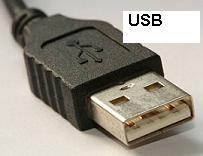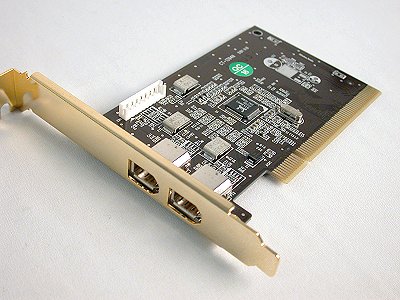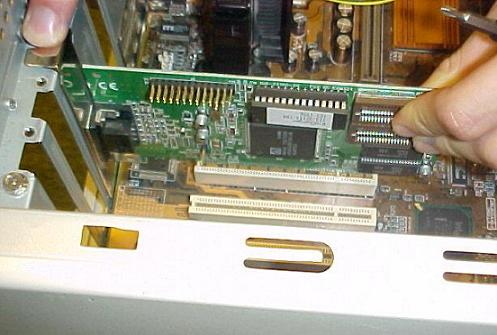Adding new capability to your PC is called "upgrading", and today I am going to tell you how easy it is to upgrade your machine to include Firewire capability.
Firewire "transfer technology" is faster than USB and can be a real benefit to those of you who own digital camcorders, or are thinking of transferring your VHS video tapes onto DVDs, or are otherwise working with digital video.
First of all, what is Firewire (aka 1394)? Firewire is, in essence, a wire (cable, actually). It looks and feels and acts very much like your quite familiar USB cabling-- it is so similar looking that they changed the shape of the plug so you can tell them apart. The USB is rectangular, and the Firewire has an angular extension on one end. 

The main difference between the two data transfer technologies is speed: the original USB speed is 12 Mbps and the original Firewire is 400 Mbps, the newer "2.0" standards (which you really should have by now) is 480 and 800 million bits per second, respectively. So, if you have large data blocks to transfer -- such as video -- from one device to another, Firewire 800 is the way to go.
Tip of the day:If your machine did not come with a Firewire port, or if it did but it is the older Firewire 400 type, upgrade your system by adding a PCI expansion card to your PC.  The photo above shows a two-port Firewire PCI card. These expansion cards come in a variety of flavors; some offer more ports, or "combo" ports like 2 USB + 2 Firewire. They are very affordable: the simple 2 port shown above can be found for $18.
The photo above shows a two-port Firewire PCI card. These expansion cards come in a variety of flavors; some offer more ports, or "combo" ports like 2 USB + 2 Firewire. They are very affordable: the simple 2 port shown above can be found for $18.
Installing an expansion card is not difficult but if you're not inclined to try it yourself, a Tech Support and/or Repair person (like myself) will not charge you much to put it in for you. It is a simple matter of inserting it into a white slot on the motherboard.
1) Load the device drivers: It may seem counter-intuitive to run the Install CD before the device is actually in the PC, but this is the usual method. Insert the CD that came with your card and follow the wizard. This will install the Plug-and-Play device drivers for your new device.
2) Prepare your PC: The next step is to completely power-down, and unplug your computer from the wall outlet. Now open your computer's case; typically there's two small screws holding your side panel in place. Lay your PC on its side so that the motherboard is down at the bottom, and you can see all the slots and components.
[Attention: Do not reach inside the case unless you are wearing an antistatic wristband, or until you have touched a bare metal section of the case's frame. A very, very small dose of static electricity can ruin electrical components inside a computer.]
Find an open (white) PCI slot, and remove the corresponding metal tab from the back of the case. This will open up an outlet for the faceplate of the expansion card.
3) Install the card: Gently, but firmly, insert the card into the open slot. You want to use enough force to fully "seat" the card into the slot.  4) Validate your install: Plug your PC back into the electrical outlet and power up your machine. Windows will launch, and it will detect your new hardware. A small dialogue window will open down by your clock that tells you that Windows is installing your New Hardware. Unless there is some glitch, you are done. You can start using your new device.
4) Validate your install: Plug your PC back into the electrical outlet and power up your machine. Windows will launch, and it will detect your new hardware. A small dialogue window will open down by your clock that tells you that Windows is installing your New Hardware. Unless there is some glitch, you are done. You can start using your new device.
* If Windows does NOT detect the new card, insert the Install CD and go through the wizard again. If this still fails to install your new card, it is likely that the card itself is not fully inserted into the slot -- power-down and really push it in this time. Repeat step 4.
If this fails (and this is unlikely), read my troubleshooting article here.
Laptop owners: For those of you who want to add this capability to your notebook PCs, the steps are very similar -- except you won't be using a PCI expansion card. You will want to purchase a Firewire PCMCIA card, such as the one shown here.
Today's free link: Teen Chat Decoder. From site: "This free Teen Chat Acronym Decoder lets you 'Crack The Secret Code' your teen uses online, in Chat Rooms, online chats, Instant Messages, & Text Messages. This is an awesome software for parents because it gives you an inside look into your teenagers online life."
Copyright 2007-8 © Tech Paul. All rights reserved.![]() post to jaanix
post to jaanix


No comments:
Post a Comment